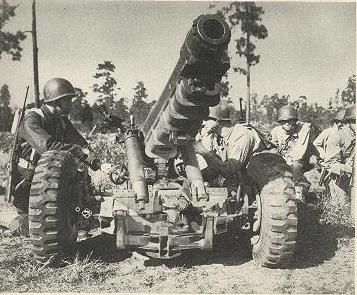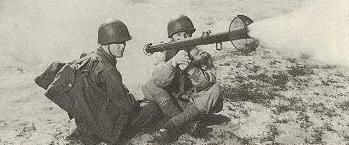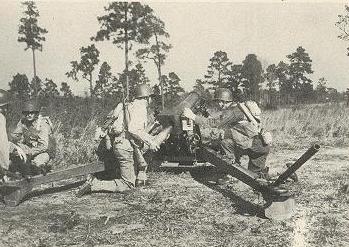Cannon Company
Click to return Training Activities
Please feel free to
provide feedback |
Camp Croft, South Carolina
US Army Infantry Replacement Training Center
|
|
The infantry Cannon Company, not to
be confused with Artillery, was tasked with the operation of the one
and
a half ton 105 mm howitzer. The company consisted of three cannon
platoon,
each platoon with two sections, and a headquarters group. Proficiency
in
the use of the M1 rifle, M1 carbine and grenades was augmented by
training
with the bazooka as an antitank weapon. The howitzer section was made
up
of a section chief, gunner, truck driver, and seven cannoneers who
alternately
performed the duties of sighting, preparing ammunition, loading, and
supplying
ammunition.
Learn more about Cannon Companies formed during W.W.II by clicking here.
|

|
|
|
 |
| |
|
While the Cannon Companies employed at Camp Croft were formed strictly
to train Infantrymen
in the basic skills necessary to operate the 105 mm Howitzer, there
were combat units
created during W.W.II which were known as Cannon Companies.
A veteran of one such unit provided most of the information below.
Cannon Company
I
was in the Cannon
Company of the 38th Infantry Regiment, 2d Infantry Division, from 1940
to
1945. I
was one of the first picked out for
transfer to the
newly formed Cannon Company because it was a chance for the HQ Company
to get
rid of their yard birds and misfits. Most of the men that came to
the
company at their own request were very beneficial and helped forge a
smooth efficient artillery/cannon company.
I might also say that they
thought I would live
longer away from the front lines because of my age, and my dare devil
approach
to what was a simple effort. It was not known as a fact but it
was
noticeable
that I was a young 16 year old who had to eat three pounds of bananas
to reach
minimum weight to pass the army physical in order to get a bed, food
and
housing for this run away from a California reformatory.
The following is what I remember about our Cannon Company and those who
tolerated me. May those that have passed on rest in peace and for
the
living, live longer with their dreams fulfilled.
I know that our unit had many
different approaches to
armament but I never saw but six M3 105 guns at any one time in
our Cannon
Company. Maybe they felt that with the proficiency displayed by
our
company commander, we didn't need more then six. Three platoons of
three
squads, two squads one gun each and one squad of ammunition carriers,
communication, support and platoon brass, noncoms and me radio
operator.
I know that Capt. John William Fritts, better known as Bill, had
great
concern about using the M3 as a direct fire weapon and this concern
proved to be
correct on D-Day+2 when we had to go up against a disabled tank
(courtesy of
some Air Corps fighter) incased in concrete on a road in Normandy with
a still
useful turret and an 88 mm, that made short work of that gun section
and
inflicted our first causalities of the war on the Indian Head
division's 38th
Infantry Cannon Company.
With nightmares of this happening, Capt. Fritts drilled into all those
Cannoneers
the theories of indirect fire and the disadvantages and advantage of
the M3
from the mortar like fire with charge one with maximum inclination to
indirect
fire with up to charge 5, the limit for the M3. I do feel that a lot of us would not be
here were it not for our
Captain's steadfast opinion on how best to train our unit for indirect
fire as
opposed to eyeball to eyeball contests with large bore 2000 pound
howitzers
with only two wheels.
As far as what each of the man's job was, I have to plead ignorance but
I do
remember the fire control center well, as my job was to repeat aloud
the quadrant
of the target and the adjustment required after the first round landed.
As far as the range of the two
howitzers the M3 had a
5700 yard range with charge 5 and artillery howitzer I believe was a M1
with a
7500 yard range with charge 7 making them both in the range of the
Germans 88
mm for counter-battery fire.
As far as the radios are
concerned, I have never seen
SCR536 (walkie talkies) used by others within a company position.
They
were a short range radio and I think they were used for training more
than
anything else, and in the movies because they were declared surplus and
dumped
right away. I carried a SCR300 a far superior radio that replaced
the BC610 (not to be confused with the SCR 610, a kilowatt AM
transmitter
that
required a truck to move). We used SCR300 radios with long and short
antennas
for both front line observer and fire control center.
We were formed at Fort Sam in San Antonio Texas and played around with some French 75
mm guns and
trained to ride in CG-4A gliders towed by C-47s C-46s. We were later
moved to Camp McCoy, Wisconsin where we played in the snow and learned
to ski and
use snow shoes and how to start frozen trucks in the morning (we had a Sherman tank platform no turret with 105 mm
sticking out
the front that we kept in the motor pools heated shop. We started
all of
our trucks by pulling that big beast out and used it to drag the other
trucks
until the wheels turned and thus started them, some times three or four
trucks
one behind the other some rolling, some sliding with the Sherman
leading
the way. Such is fun!
When
spring came we were
train as Rangers learning Judo and some live fire courses training, but
we were
allowed to practices with all these small tanks and big Sherman's etc. When we arrived in Ireland we were issued the little M3 105 mm
Howitzer and
fell in love with them. Then I went to Fort Benning for radio training. I came back in time
for leave to go back to California to visit then back to Camp McCoy with news that Wenchell, a newscaster,
asked the question on the air
"What was some regular army General doing with some regular Army
division
in the hills of Wisconsin when troops are so direly needed on the
front?" A week later, October 10, 1943, we were on our way.
Thanksgiving
day we lost
our first man while still in Ireland, just before dinner two of our
guys were
doing a fast draw and stab contest with trench knives one was stab
right
in the heart. We stood and watched, blood pumping out of his chest and
subsequently dying. That made the T.G. day dinner somewhat of a
flop.
---
John Johnson, April 2005
My
late father Elmer D. Schorry, 87th Division, 346th Infantry Regiment,
Cannon Company used the M3 105 mm howitzer, exactly as shown on your
website. Dad told me that very late in the war in the ETO they
received gun shields but found them to be cumbersome and quickly
abandoned them in the Ardennes somewhere.
The
87th received their basic training at Camp McCain, MS, thence got
further training, and dad became a cannoneer at Ft. Jackson, SC.
Later they moved to Camp Kilmer, NJ, and in fall '44 went to
England. In Nov. '44 they got to France through Le Havre.
They went into combat on Dec. 14, 1944 (two days before the Bulge broke
out). The 346th Cannon Company was in 154 straight days of
combat. In July '45 they were back in the States for a 30 day
furlough, and were then mustered out in Sep. '45. War's end of course
kept them from being part of Operation Olympic, the Japan invasion.
Thanks
for the website!
-- Rob
Shorry, March 2005
|
|


